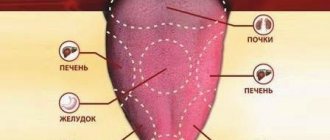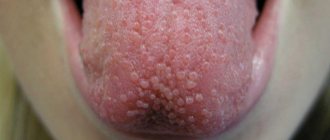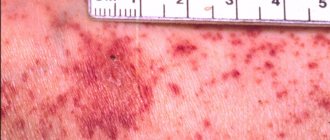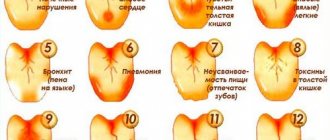In this article we will look at what a brown spot on the tongue means.
Language is a kind of indicator of the state of the human body. The appearance of brown or other colored spots on it often causes confusion among most people, but this phenomenon is by no means rare.
Dark spots on the tongue can appear in adults and children; their color can vary from dark brown to light gray.
Brown spots on the tongue of an adult can be located on the side or upper surface, can have a lumpy structure, and affect other areas of the oral cavity, lips, and sometimes the face. They can appear for a variety of reasons.
Spots on the tongue can be permanent, appear once and then disappear on their own, or be periodic. Sometimes they are accompanied by discomfort or pain. In such a case, there is a possibility of developing tongue cancer or a serious infection.
Hyperpigmentation
Brown spots on the tongue of an adult may occur due to hyperpigmentation. This happens due to the high concentration of melanin in the body. It is this substance that colors hair, eyes, and skin. If a large amount of melanin accumulates in the tissues of the tongue, harmless dark spots begin to appear. Hyperpigmentation of the tongue is caused by melanocytes - pigment cells.
However, sometimes brown spots on the tip of the tongue, caused by hyperpigmentation, are evidence of the development of melanoma, a type of cancer. Typically, melanoma develops under exposure to UV rays from the sun. The risk group includes people over 40 years of age, in particular women. As a rule, melanomas are brown or black in color, however, they can also be purple, red, or pink.
A photo of a brown spot on the tongue is presented.
Traditional medicine involves removing pigmentation using a laser. In folk medicine, rosehip, aloe vera, cucumber, lemon, and potato juices are used to lighten darkened tongue and skin.
Melanin production is reduced by hydroquinone. It contains calcium, kojic and azelaic acids, cucumbers, soy milk.
Oral fibroma
Fibroma is a benign tumor that has the shape of a polyp or dome, that is, it is a formation that resembles a hard, smooth round lump, which with its base or stem is attached to the tissues of the oral cavity. They look like moles and freckles and may have a dark color. Fibroma can occur for various reasons, for example, due to irritation caused by exposure to dental devices, piercings, and teeth.
Therapy for such a tumor can only be surgical; however, surgery does not guarantee that the tumor will not reappear in the same place. Treatment should not be neglected, since fibroids can multiply and grow. In addition, you should avoid damaging the tongue, particularly in the area where the fibroid was previously located. Trauma can trigger its growth again.
Oral cancer
Tongue melanoma is a less common type of oral cancer. Brown spots on the tongue caused by oral cancer are extremely rare. You can assume the occurrence of cancer if its appearance is accompanied by other symptoms - difficulty moving the jaw when speaking, swallowing, bleeding wounds on the face, neck, mouth, hoarseness, chronic soreness in the throat.
In this case, you should not give in to panic; cancerous tumors can be treated with chemical medications, radiation, which destroys carcinogenic cells, as well as through surgery aimed at removing the tumor.
Tongue piercing
In some cases, pigmentation disappears in the tongue piercing area, leaving only dark-colored spots. They can occur not only due to bleeding that occurs during the puncture, but due to the presence of jewelry in the oral cavity.
If an infection occurs during the piercing, it should be treated in a timely manner. In addition, it is important to perform all necessary postoperative manipulations and use only gold or titanium jewelry, as they are the least allergenic.
Diagnostics
To determine what disease led to the appearance of unpleasant symptoms, an examination is necessary. Diagnosis may include:
- General and biochemical blood test;
- Stool and urine analysis;
- Fluorography and ultrasound;
- Gastroscopy;
- Bacterial culture from the tongue;
- Coprogram;
If a dark coating appears on the tongue, adults should first consult a therapist, and young patients should be shown to a pediatrician. After examination, history taking, palpation of the abdomen and other manipulations, the patient is referred to a specific specialist. Most often, a consultation with a gastroenterologist and an infectious disease specialist is needed. Also, the patient can be referred to an endocrinologist, otolaryngologist, pulmonologist, or toxicologist. The dentist is very helpful.
Black hairy tongue
What does it mean if a brown hairy spot appears on the tongue? This phenomenon can be caused by smoking, drinking alcohol, poor oral hygiene, and excessive use of antibiotic medications. Such spots appear due to the proliferation of papillae on the tongue.
Science has not fully elucidated the exact causes of brown spots on the tongue, however, as practice shows, the problem disappears over time if the patient carefully monitors oral hygiene and stops smoking and drinking alcoholic beverages.
They can be lightened or turned pink by eating mints or using mouthwash.
In addition, the phenomenon of a black hairy tongue may be due to the development of candidiasis in the mouth. It is important to ensure that the diagnosis is correct and then begin treatment for such spots through the use of antifungal medications.
Causes of dark plaque on the tongue
Thick deposits that cannot be cleaned off can indicate serious problems in the functioning of the body. The causes of deposits can be both internal and external. The latter include:
- Taking medications such as Faringosept, Malavit, steroids, drugs that contain bismuth.
- Deficiency of nicotinic acid or vitamins PP, group B.
- Black spots appear due to lead poisoning.
- Tobacco smoking, excessive indulgence in fatty foods, sweets, and alcohol.
- Dehydration or acidosis.
The reasons for the appearance of dark plaque lie in many diseases.
- Advanced oral candidiasis and stomatitis.
- Severe disturbance of the microflora of the oral cavity.
- Progressive diseases of the gastrointestinal tract in chronic form - gastritis, enterocolitis, dysbacteriosis, liver pathologies, cholecystitis, pancreatic diseases.
- Advanced infectious diseases - pneumonia, arthritis, blood diseases, tonsillitis, nephritis, cholera.
Tongue injuries
As a result of injury to the tongue, dark red or dark brown blisters may appear on it. They have this color because there is blood inside.
Dark spots can occur due to trauma to the tongue, especially if it results in sores. For example, due to piercings, dental surgery, tongue biting.
What else can cause a brown spot on the tongue?
Allergic manifestations and the result of exposure to certain medications
Certain chemicals, such as bismuth, can cause stains in the mouth. In addition, some medications that are allergens can cause tongue spotting.
To solve this problem, it is important to prevent contact with the allergen, take antihistamines, and continue therapy if the spots do not disappear.
Additional symptoms for making an accurate diagnosis
In diagnosing diseases that cause blackening of the mucous membrane, other symptoms are also important. They allow you to more accurately determine the factor causing this pathology.
- the shade of the mucous membrane of the tongue itself: it can range from yellow-gray to black with a blue or green tint, it can have a brown color,
- localization of plaque: for example, a large black spot in the center of the tongue or at its root indicates gastrointestinal problems or complications after infectious lesions. Small black dots indicate fungal infections or chemical poisoning,
- mobility of the substrate (how easily it is removed from the surface of the organ),
- change in the relief of the back (formation of folds, growths, etc.),
- the presence of ulcers, abscesses or erosive lesions on all oral mucous membranes,
- presence of bad breath,
- the presence of a foreign taste: for example, bitterness indicates problems in the functioning of the gastrointestinal tract, a metallic taste indicates lead vapor poisoning, and sour taste indicates a fungal infection.
Therapy
If a person develops dark brown spots on the tongue, it is important to consult a doctor and be examined for oncological pathology, since timely therapy in this case will solve the problem. Temporary stains, in particular those resulting from chemical exposure, can be eliminated through proper oral hygiene.
Oral hygiene involves carefully cleaning the deposits on the tongue with a soft brush. In addition, it is important to eat healthy whole foods, fruits, and vegetables.
Many pathologies accompanied by this symptom respond well to treatment with medications and vitamin complexes.
Treatment of the surface of the tongue can be carried out using effective resorption medications - “Imudon”, “Lizobakt”. You can also make oral baths based on decoctions of medicinal herbs (chamomile, sage) or antiseptic solutions of pharmaceutical origin (Miramistin, Chlorhexidine).
If spots on the tongue are caused by a fungal infection, the patient is prescribed bifidobacteria, lactobacilli, and probiotics to normalize the microflora. In addition, the use of antifungal drugs is indicated - Livarol, Fluconazole, Nystatin, Diflucan. Antiseptic solutions are used for local treatment of the oral cavity.
In some cases, experts recommend treating the mouth with liquid nitrogen. Such a procedure should be carried out exclusively in a medical facility and only under the supervision of a doctor. Self-treatment with nitrogen is unacceptable. It is worth noting that in the field of dentistry, this method of therapeutic effects has not found wide application.
In cases where conservative therapy in the form of medication does not bring the required result, experts recommend surgical intervention.
You can also remove such stains by sucking on a small piece of pineapple, then holding it on the root of your tongue for 40 seconds and chewing for 8 minutes. This should be done twice a day for 14 days.
Treatment
Your doctor will tell you how to treat various pathological conditions. The most difficult thing is to get an appointment with the right specialist and determine the problem, because treatment will be aimed not so much at eliminating the external defect, but at relieving the internal disease.
Therapy for some diseases may take only a few days, while for others it may take months or even years. The duration of treatment depends not only on the type of disease, but also on the degree of its neglect. That is why doctors recommend closely monitoring your health and not delaying a visit to a medical facility, even if the pathology seems insignificant. Don't ignore even a little redness.
Prevention
The first and main preventive rule is compliance with individual oral hygiene standards. To clean the tongue, you should use special devices, for example, scrapers. It is also important to eat right, saturate your diet with foods rich in iron. You should stop drinking alcohol and smoking.
It is necessary to visit the dentist in a timely manner if suspicious symptoms appear, to eliminate dental diseases, and to remove tartar.
It is important to remember that such a phenomenon as brown spots on the tongue is not only unaesthetic, but it can indicate the development of probable serious diseases in the body, which can only be identified by a qualified specialist.
We looked at why a brown spot may appear on the tongue.
How to get rid of brown plaque
When the tongue is covered with a brown coating, and it practically cannot be removed, it is necessary to treat the disease that provoked the unpleasant symptom. If the buildup reappears after using a ribbed brush to clean your mouth, contact your dentist. He will refer you to a specialized specialist. This could be a gastroenterologist or infectious disease specialist, a toxicologist or dentist, an endocrinologist or another doctor. One thing is clear, the disease that caused the deposits needs to be treated. Then the substrate on the receptor organ will disappear.
To compensate for vitamin deficiency, in addition to balancing the diet, special complexes are prescribed. It is recommended to carry out general preventive measures.
- Eat a balanced diet and maintain healthy microflora in the intestines.
- Drink enough water.
- Introduce more fiber into your diet.
- Include natural fermented milk products in the menu.
- Consume food often and in small portions.
- Give preference to natural sorbents, for example, bran and pumpkin.
Consult your doctor and follow all his instructions.










